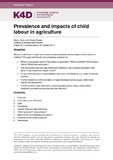| dc.contributor.author | Carter, Becky | |
| dc.date.accessioned | 2017-11-16T14:39:39Z | |
| dc.date.available | 2017-11-16T14:39:39Z | |
| dc.date.issued | 2017-05-05 | |
| dc.identifier.citation | Carter, B. (2017). Prevalence and Impacts of Child Labour in Agriculture. K4D Helpdesk Report. Brighton, UK: Institute of Development Studies. | en |
| dc.identifier.uri | https://opendocs.ids.ac.uk/opendocs/handle/20.500.12413/13345 | |
| dc.description.abstract | This exploratory rapid review finds that child labour in agriculture is a global issue, with the agricultural sector accounting for the majority of child labourers. Across regions and countries agriculture is usually the main sector for children’s economic activity. However, there is considerable variation in the prevalence of child labour between and within countries. Agricultural child labour is mainly unpaid work on smallholder family farms, but is also found on commercial farms and plantations as well as through forced and trafficked child labour. Child labour is involved in crop production, livestock (including herding) and forestry as well as fishing and aquaculture. There are more boys than girls in agricultural child labour, and both tend to start young, sometimes before 10 years old. Girls tend to combine agricultural and domestic duties, and their work is more invisible, while male adolescents are more likely to be in hazardous work in agriculture than their female peers. Children from poor households, ethnic minorities, migrants and families with HIV/AIDS or disabled members are particularly vulnerable to agricultural child labour. Other drivers include agricultural dependency, social norms and a lack of higher returns to basic schooling. Almost 60 per cent of girls and boys (aged 5–17 years) in hazardous work are found in agriculture. Situations of heightened harm and danger include forced and trafficked child labour for agriculture as well as conflict and emergency situations. Nevertheless age-appropriate tasks can contribute to children’s well-being and development – in particular in rural contexts with a lack of returns to formal education, labour-intensive agricultural livelihoods and social acceptance of child labour. | en |
| dc.language.iso | en | en |
| dc.publisher | Institute of Development Studies | en |
| dc.relation.ispartofseries | K4D Helpdesk Report; | |
| dc.rights.uri | https://www.nationalarchives.gov.uk/doc/open-government-licence/version/3/ | en |
| dc.subject | Agriculture | en |
| dc.subject | Children and Youth | en |
| dc.subject | Livelihoods | en |
| dc.subject | Work and Labour | en |
| dc.title | Prevalence and Impacts of Child Labour in Agriculture | en |
| dc.type | Helpdesk | en |
| dc.rights.holder | DFID | en |
| dcterms.dateAccepted | 2017-10-20 | |
| rioxxterms.funder | Default funder | en |
| rioxxterms.identifier.project | K4D | en |
| rioxxterms.version | NA | en |
| rioxxterms.funder.project | 0986883a-6d0f-4bb8-9c46-5e0682934d65 | en |

